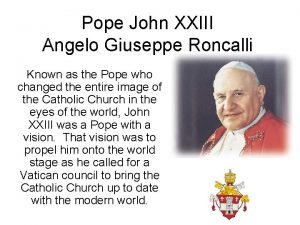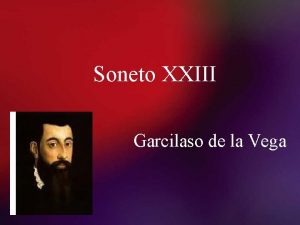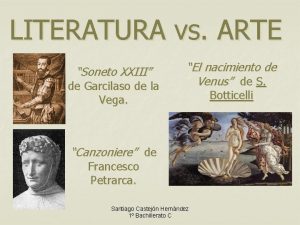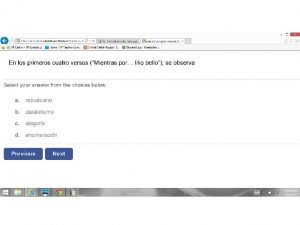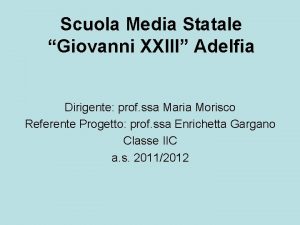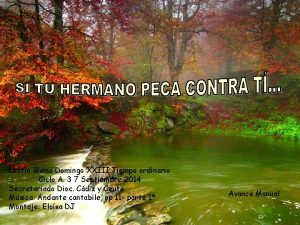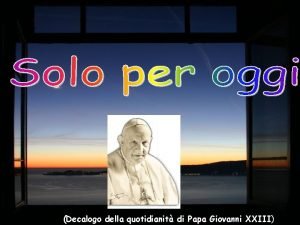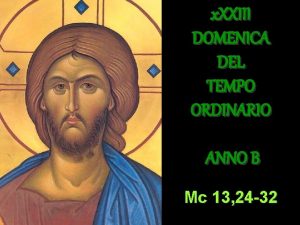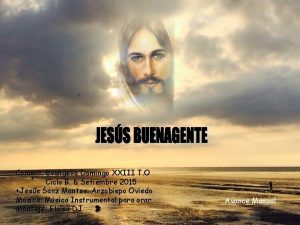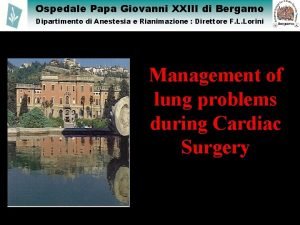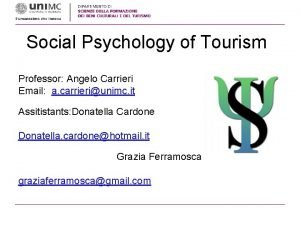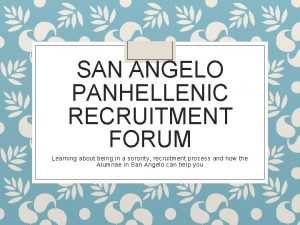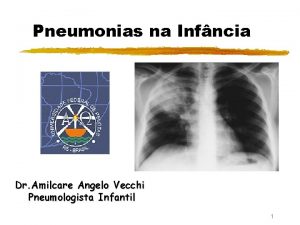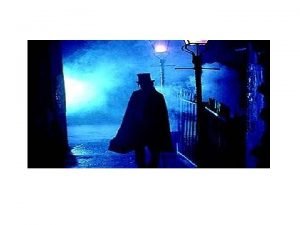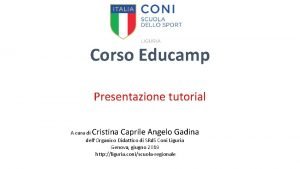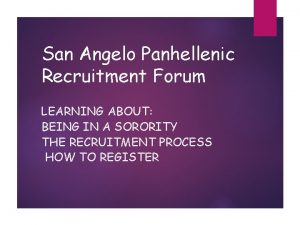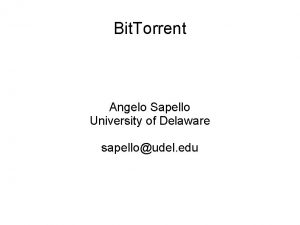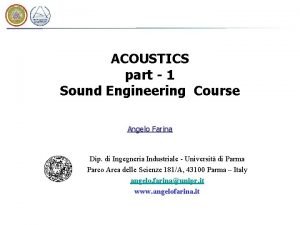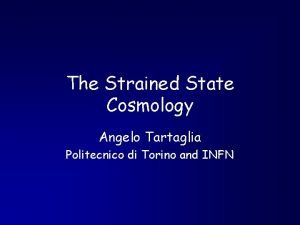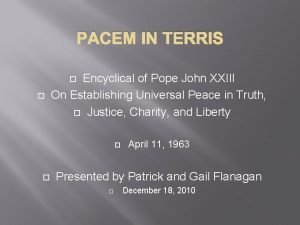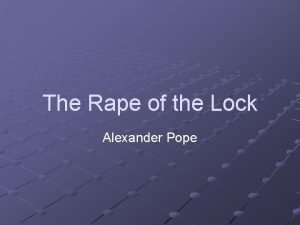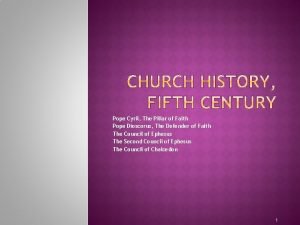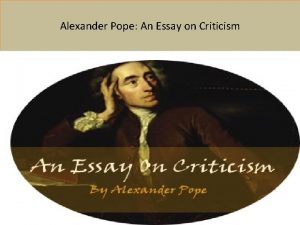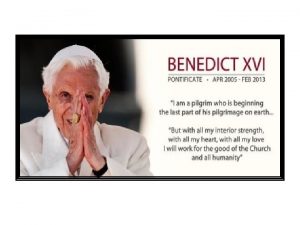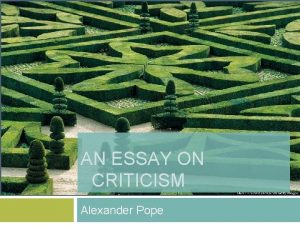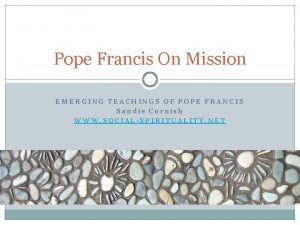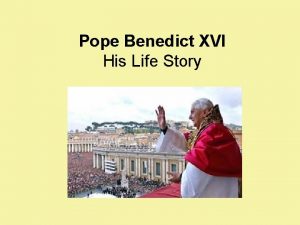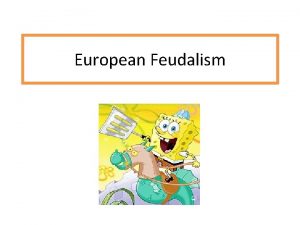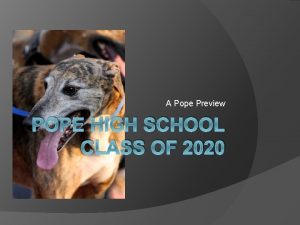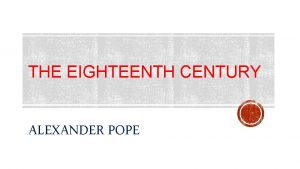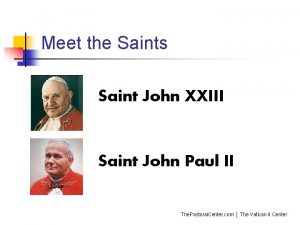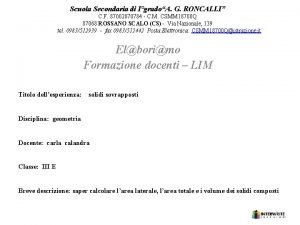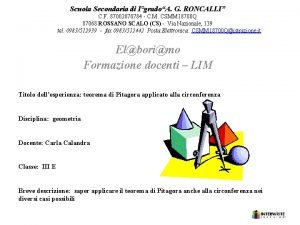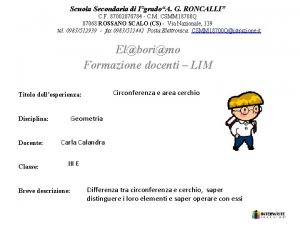Pope John XXIII Angelo Giuseppe Roncalli Known as






























- Slides: 30

Pope John XXIII Angelo Giuseppe Roncalli Known as the Pope who changed the entire image of the Catholic Church in the eyes of the world, John XXIII was a Pope with a vision. That vision was to propel him onto the world stage as he called for a Vatican council to bring the Catholic Church up to date with the modern world.

Early Life • Born in Bergamo, Italy 25 th November 1881. Angelo was the fourth child of 13. His family recognised his devotion to study and religious life and he entered the seminary to study for the priesthood when he was 12, however he was not ordained until he was 23. His brilliant mind soon singled him out by his superiors and he was sent to Rome to further his studies. Parents

Postings abroad - Bulgaria • In 1925, Pope XI appointed him as Apostolic visitor in Bulgaria with Episcopal functions. He established himself with the Catholic church there and was well received especially when he appointed a Bulgarian as Apostolic administrator. This meant that when he left the previously troubled Bulgarian church, it was left with a solid organisation.

Istanbul • In 1934, he became apostolic delegate in Turkey and Greece with a permanent dwelling in Istanbul. Once again, his diplomacy endeared him to the orthodox Church leaders as he visited them and cultivated active friendships and cancelled all prejudices. Within the Catholic church there, he acted with liturgical majesty and was respected by all in the orthodox church for his humble nature and his appreciation of all that was Christian. He visited the ancient orthodox monasteries and churches and venerated their icons. In this way, he forged an ecumenical understanding with these brothers in Christ. When Pius XI died, the Eastern orthodox Church leaders and Eastern Church leaders turned out in force to pay their respect so much so that their appearance together was remarkable.

Courage and Foresight • In his role, during the war, he protected the people of Athens from shelling by the Germans by having it declared an “ open city” like Rome. He was noted for his ability to hide Jews from the Nazis’ searches and by persuading the British not to consider Greece in their embargo of the Greek Coast, thus saving the Greek people from starvation.

France • In 1944, he was appointed as the Papal Nuncio to France. He also had the job of lifting the image of the Catholic church as it was treated with scepticism after its association with the Germans. He travelled all over and made his presence felt at every religious event and was known for his cordiality, modesty, his charity, his wit and his total acceptance of all without exception.

North Africa and Venice • In 1950, he visited the French territories in North Africa and travelled 38, 000 miles in ten days without any special privileges. • His next posting to Venice was as a cardinal and Patriarch of Venice. In five years, he raised up 30 parishes, smartened up the cathedral, and continued his Ecumenical apostolate with separated Christian brothers. Without doubt, his affable nature, wisdom and geniality had won him a place in the hearts and minds of the Venetian population and crowds of them turned out when he left for Rome after Pius XII’s death.

The Conclave votes • With the death of Pius XII, Cardinal Roncalli joined the conclave to elect the new pope. The black smoke on 28 th October 1958 announced the beginning of his Papacy. He was 77 years old.

Contribution to Christianity • Pope John XXIII, in his role as a new pope, saw the need to bring the Catholic Church up to date with the rest of the world. Thus, he proposed to convoke an Ecumenical council- Vatican II and apply a Spirit of Aggiornamento (updating or renewal) to the outdated Catholic Church. • He put this idea forward on January 25 th 1959, 3 months after his election. This elderly pope surprised everyone with his vision, enthusiasm and dynamism as well as with his deep love and understanding of Christianity and God.

Vatican II • The Second Vatican Council was a meeting of the world’s bishops for four 10 week sessions between October 11, 1962, and December 8, 1965. Its aims were: • That the Catholic Faith should be kept and taught • But taught in the language of modern man by a Magisterium which was pastoral in character. • and this without resorting to any condemnations, • thus appealing to all peoples (this Council was to be ecumenical, not only in the sense of being a general council of the Church, but also in that of appealing to the religiosity of all people of whatever religion).

Contribution- Vatican II • John XXIII’s diplomatic work had instilled in him a real understanding of the people and the needs of the Catholic Church. The 16 documents drawn up were faithful to the Catholic Tradition and applicable to the needs of the time, stated in fresh up to date language, with references to the Bible and also to the Fathers of the Church.

Contribution- Vatican II • Changes to the liturgy – Priest now faced the congregation instead of turning his back to them. • Language of the Liturgy was now in the vernacular • The Catholic Church was now more Ecumenical in its approach to other Christian variants. • The role of the Laity was given more prominence and more involvement in the Church • New prayers and music were introduced • Catholics were now allowed to read and study the Bible

Contribution -Social Concerns • Mater et Magistra – This Encyclical advocated social reform, assistance to underdeveloped countries, a living wage for all workers, and support for socialist measures that promised better conditions for society. • In brief, it detailed the need to have family values – truth, justice, charity and freedom. These ultimately will lead to raising awareness of world values.

Contribution – Social Concerns- Pacem in Terris • This Encyclical set out the guidelines for all people to live in peace. • He focused on the dignity of the person made in the image of God, Genesis 1: 26, as being of paramount importance for all people. • Respect for human goodness, peace and justice along with the basic rights of every human being that should be recognised throughout the world. • “Pacem in Terris” addressed to all mankind, set out the recognition of human rights and duties as the foundation of world peace and pressed for peaceful coexistence between the West and the communist East.

Contribution- Social Justice- Decree on the Apostolate of the Laity • This document advocated both the missionary vocation of the laity and their having a more prominent role in the Catholic Church. To highlight this, the Pope, Paul VI, who carried on John XXIII’s work after his death, used the passage from 1 Peter 2 : 4 -10 “ They are consecrated for the royal priesthood and are a holy people. ” • In addition, it addressed the critical role of the laity in assisting the Church to bring God’s Kingdom to fruition through involvement in social Justice. • In Australia today, lay people are involved in Catholic education and mission, Caritas. the Edmund Rice foundation, the Matthew Talbot hostel for the homeless, and the Vinnies night patrol bringing food to the poor every night of the week.

Contribution- Democracy and Empowerment- Dogmatic Constitution of the Church- Lumen Gentium • John XXIII had a vision for the Church where the laity were incorporated as sharing in the light of Christ. “Thus, the Church has been seen as "a people made one with the unity of the Father, the Son and the Holy Spirit. " • This meant that everyone is equal in the eyes of God. • Furthermore, this document reaffirms the dogma of the Catholic church and in particular the call to holiness and the role of each one as part of “ the mystical body of Christ”. 1 Co 12: 12 – 31 • The role the Catholic church as a pilgrim Church working towards bringing all people to God.

Democracy and Empowerment- Constitution on the Sacred Liturgy - Sacrosanctum. Concilium • John XXIII listened to his bishops and made the necessary changes to the Liturgy in this document. • The Mass was celebrated with the priest now facing the people. • The Latin was replaced with the language of the people. • New Hymns and prayers were introduced. • Christ was acknowledged as being present in the ordained minister, in His Word, in the Sacred Species and in the congregation. • Lay people were to be “active participants” in the Liturgy now. This gave further momentum to the decree on the Laity.

Ecumenical Church- Decree on Ecumenism- Unitatis Redintegratio • John XXIII had a passion to unite Christian Churches and his visionary impetus in this document heralded in a new age in the history of the Catholic Church and its relations with its Christian brothers and sisters. • The decree on Ecumenism assumes that genuine unity is based on truth. • Primarily, all Christians must trust in the grace of God and the guidance of the Holy Spirit to come together with other Christian Churches as God wills. • John XXIII in his ministry as the Vicar of Christ openly invited leaders of other Christian variants to dialogue with him and set a precedence for the future of the Catholic Church. Greeting Russian Schismatics Greeting Episcopalians Greeting Methodists

Aggiornamento- in practice- Gaudium et Spes • This document was at the heart of John XXIII’s Aggiornamento bringing the Church up to date with the modern world. It has a focus on the human person made in God’s image, the dignity of marriage, and family life, the proper development of culture, mankind’s economic and social life, the political community, the fostering of peace, and the establishment of a community of nations. Its main goal is to provide practical principles to guide Catholics in how to relate to the modern world and in ways of approaching matters of concern.

Analysis cont. • He was always innovative and even as a priest having made a detailed study of St. Charles Borromeo (a model pastoral bishop) of whom he was to write 5 volumes, (his chosen patron saint), John XXIII modelled his own life on him, thus becoming the inimitable, disciplined priest, bishop, administrator, cardinal and pope. • He would always set aside time each day for prayer and meditation to develop his own spirituality just as St Charles had advocated. • John XXIII’s diary, Journal of a Soul, published after his death were his personal spiritual reflections written from his seminarian days to his papacy and have inspired many who have read them. • Vatican II, he reflected, was his prayer for a “new Pentecost”.

Analysis Cont. • The Reforms of the Sacred Liturgy made the Mass and other liturgical celebrations more meaningful and understandable to most Catholics. Participation and involvement in the Liturgy by the laity became more visible and the use of new music and shared responses enlivened the Worship service. • Ecumenism became a new focus of the Catholic Church and this has assisted the Christian churches to give greater witness to the community. Each pope since John XXIII has supported and continued this work. Christian Churches around the world now work together on social justice issues and in serving the community in times of need. John XXIII visiting prisoners

Analysis- Cont • The reforms of Vatican II gave rise to a greater involvement by the Laity and an outpouring of spirit within the community. New movements such as (the Charismatic movement) within the Church sprung up and Catholics the world over have become more concerned with and involved in social justice and life of the parish.

Analysis- Cont • Through Vatican II, the Church grew closer to contemporary men and women and made the Gospel more meaningful to them. • John Paul’s vision of inclusiveness in Vatican II also extended to Orthodox, Protestant and Catholics and this made this council a historic event. His earlier experiences with other Christian variants broadened his outlook and his vision and paved the way for a new and visionary pope, an epiphany in a church that had not changed dramatically for 400 years. • He also welcomed a Shinto high priest to the Vatican.

Analysis - cont • Throughout the Church, there was a renewed interest in the Scriptures, Liturgy and Spirituality. • Ordinary people began to study theology and teach it. • Eastern Catholic Churches were encouraged to return to their own traditions, thus ending a period of Latinisation and adding diversity within the Roman Rite. • The Council formally acknowledged the possibility of salvation for non Christians and this began a period of dialogue with other non Christian Churches. (Interfaith) • The Catholic Church has continued to expand build on the work of Vatican II over the last 40 odd years. It has developed more as a pilgrim Church with each successive pope following a pilgrim’s journey. World Youth Day is an example of this and it too, has expanded and contributed to the John XXIII”S ideal of the Spirit working within the people made in the image of God.

Analysis- cont. • The Council restored the permanent Diaconate as a ministry and allowed married men to become deacons. • Religious life changed damatically with most adopting modern dress and rewriting their own constitutions, adopting a new look at issues of authority, identity and community. • Theology was revitalised especially moral theology which focused on Biblical sources and individual conscience and less on Church law or authority. • Overall, the council underlined the Church’s solidarity with humanity instead of separation with the secular world and this has led to a mushrooming of social and charitable activities. Bishop Higi ordains five deacons

Analysis –Hermeneutics of Continuity • After John XXIII’s death, each succeeding pope continued interpreting and developing his ideas in the light of Catholic tradition and the belief that there is always an ongoing revelation by the Spirit of the Lord within the Church. • Paul VI was given the task of engineering and implementing the ideals of John XXIII’s Vatican II and overseeing the reforms while maintaining the traditions of the Church. • JP II pictured with then, Greek Orthodox leader, Archbishop Christodoulos in 2001 was a very ecumenical pope who also developed great interfaith acknowledgement. This was particularly evident at the great man’s funeral which was attended by representatives from interfaith churches and Christian variants. • Benedict XVI meeting members of the Park East Synagogue in New York. He was praised for his interfaith efforts.

Analysis of his work • John XXIII astonished the world and the Church with his energy, vision and spirit of reform. He expanded and internationalised the college of Cardinals, called for the first diocesan synod of Rome in history and convened the second Vatican council to revitalise the Catholic Church. In so doing, he forged a new era in the history of the Catholic church and brought it up to date with the modern world. • The extraordinary transformation of the Catholic church renewed and re- energised the outdated Church in such a way that it is still forging ahead with the reforms and providing stronger witness to the teachings of Christ.

Bibliography - Books • Bulmer, K and Doret, K (2008) HSC Studies of Religion, Pascal Press, Glebe • Hayward, Patricia, et. al (2007) Macquarie Studies of Religion, Macquarie press, Melbourne. • Schreck, Allan(1987) The Compact History of the Catholic Church Servant Books, Michigan. USA • Smith, H. et. Al. ( 2007) The Leading Edge, SC Studies of Religion, Study Guide. , Harcourt Education, Melbourne.

Bibliography • http: //www. aviewoncities. com/rome/sanpietro. htm • http: //www. catholic-forum. com/saints/pope 0261. htm • http: //www. catholicnews. com/data/stories/cns/0505787. htm • http: //www. crossroadsinitiative. com/library_author/123/Pope_John_X XIII. html • http: //elvis. rowan. edu/~kilroy/jek/06/04. html • • http: //faithfulrebel. blogspot. com/2008/01/pope-celebrates-facing-altarliberals. html http: //www. geocities. com/ganesha_gate/roncalli. html • http: //www. google. com/imgres? imgurl=http: //www. sspx. org/images/V atican/vatican. II 300 x 327_lr. jpg&imgrefurl=http: //www. sspx. org/SSPX_ FAQs/q 6_vatican. II. htm&h=327&w=300&sz=38&tbnid=vbyiu. Lo. Lw 7 g. J: : &tbnh=118&tbnw=108&prev=/images%3 Fq%3 DVatican%2 BII%2 Bpi cs&usg=__2 Xv. TFmp. F 0 r. Lwa. Q 2 GSVYAUKpbr. Y=&sa=X&oi=image_result&resnum=1&ct=image&cd=1 • http: //www. mostholyfamilymonastery. com/new_John. XXIII_photos. html • http: //www. papagiovanni. com/english/index. htm

Bibliography cont. • http: //www. google. com/search? ie=UTF-8&oe=UTF 8&sourceid=navclient&gfns=1&q=decree+on+the+apost olate+of+the+laity+pics • http: //www. vatican. va/archive/hist_councils/ii_vatican_co uncil/documents/vat-ii_decree_19651118_apostolicamactuositatem_en. html
 Giuseppe roncalli
Giuseppe roncalli Contexto historico de soneto xxiii
Contexto historico de soneto xxiii Decalogo de la serenidad
Decalogo de la serenidad Soneto xxiii
Soneto xxiii Friauche le dernier jour d'un condamné
Friauche le dernier jour d'un condamné Ic giovanni xxiii mogliano
Ic giovanni xxiii mogliano Prosopopeya
Prosopopeya Scuola giovanni xxiii adelfia
Scuola giovanni xxiii adelfia Lectio divina domingo xxiii ciclo b
Lectio divina domingo xxiii ciclo b Scuola media giovanni xxiii arona
Scuola media giovanni xxiii arona Metrica de la rima xi de becquer
Metrica de la rima xi de becquer Decalogo della quotidianità di papa giovanni xxiii
Decalogo della quotidianità di papa giovanni xxiii Habia un juez que no teme a dios
Habia un juez que no teme a dios Xxiii domenica del tempo ordinario anno b
Xxiii domenica del tempo ordinario anno b Domingo xxiii ciclo b
Domingo xxiii ciclo b Ospedale papa giovanni xxiii
Ospedale papa giovanni xxiii Social psychology
Social psychology San angelo panhellenic
San angelo panhellenic Dr amilcare
Dr amilcare Dr angelo costas
Dr angelo costas Christine kizuka buono
Christine kizuka buono What is the general profile for a serial killer?
What is the general profile for a serial killer? Angelo gadina
Angelo gadina Angelo corallo unisalento
Angelo corallo unisalento Angelo mario venditti
Angelo mario venditti Adam d'angelo quora
Adam d'angelo quora San angelo panhellenic
San angelo panhellenic Angelo state dual credit
Angelo state dual credit Sally d'angelo torrent
Sally d'angelo torrent Angelo farina
Angelo farina Angelo tartaglia politecnico torino
Angelo tartaglia politecnico torino
